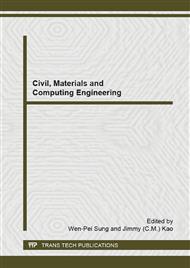[1]
Wang Mengzhong, Huang Yingchang. Application of adhesive Handbook [M]. Beijing: Chemical Industry Press, 1987: 251 ~ 252 and 878 ~ 880.
Google Scholar
[2]
Wang Zhiling, Wang Zheng. Artificial plate with the status quo and development trend of [J]. Chinese isocyanate adhesive adhesive, 2004, (1): 59 ~ 60.
Google Scholar
[3]
Liu thousands. Wood structure strength of the D field. Harbin: Northeast Forestry University press, 1995. 45 ~ 50.
Google Scholar
[4]
Tang Li. Analysis of furniture structure strength and calculation method on data compilation. Furniture Science & technology, 1982: Third: 66 - 70.
Google Scholar
[5]
Li Lanting adhesives and coatings Suo. Beijing: China Forestry Press, 1996. 36 - 40.
Google Scholar
[6]
Liu Yixing, Li Jian, Xu Zicai, Cui Yongzhi, analysis, forestry science, 1995 comprehensive statistics of China's 110 species of wood surface visual physical magnitude, (04).
Google Scholar
[7]
company transfer. Furniture corner on the bonding properties of D. Harbin: Graduate School of Northeast Forestry University, 2002. 6.
Google Scholar
[8]
Wang Xuerong. Research progress of acrylic emulsion adhesives field. China adhesive, 2005 (11): 23-24.
Google Scholar
[9]
Fang Ji, Hou Linying, Hou Xiangrui. Changchun University survey of [J]. development and utilization of firSinica, 2006, 16 (1): 67 69 Release the.
Google Scholar
[10]
National Bureau of standards. The people's Republic of China national standard GB-9846. 1 to 9846 12- 88 plywood. Beijing. Chinese Forestry Press, (1989).
Google Scholar
[11]
Wu Hui, Xia Yamin, Ming forces, two-component waterborne polyurethane resin preparation method of [J]2004. 34 (12) 31-25.
Google Scholar
[12]
Tanaka beam, Inoue Onari, sang Ziyan as read, aqueous polymer isocyanate adhesive for wood, Journal of the Chemical Society of Japan 1996 (1), 1 ~ 7.
Google Scholar
[13]
Chen Lijuan, the aqueous polymer isocyanate adhesive research [Master thesis. Harbin: Northeast Forestry University, 20000.
Google Scholar
[14]
Ma Tianxin, study on the modification of polyvinyl alcohol adhesive toluene diisocyanate. Bonding, 1997, 18 (3): 9 - 10.
Google Scholar
[15]
Li Shaoxiong, Liu Yijun Bian Zhu. Polyurethane adhesive [M]. Beijing: Chemical Industry Press, 1998: 20 ~ 23 and 105 ~ 106.
Google Scholar
[16]
Niu Yongsheng, Song Haixiang, Dai Haichao, et al. Have diisocyanate on PVA Adhesive Modified Research [J]. Henan chemical industry, 1999: 19 ~ 20.
Google Scholar
[17]
summer Chidan, Yu Hannian, Zhou Libin, et al. Research on [J]. chemistry and adhesion, diisocyanate and aqueous polyvinyl alcohol adhesive based crosslinking reaction of toluene 2001, (5): 197 ~ 199.
Google Scholar


